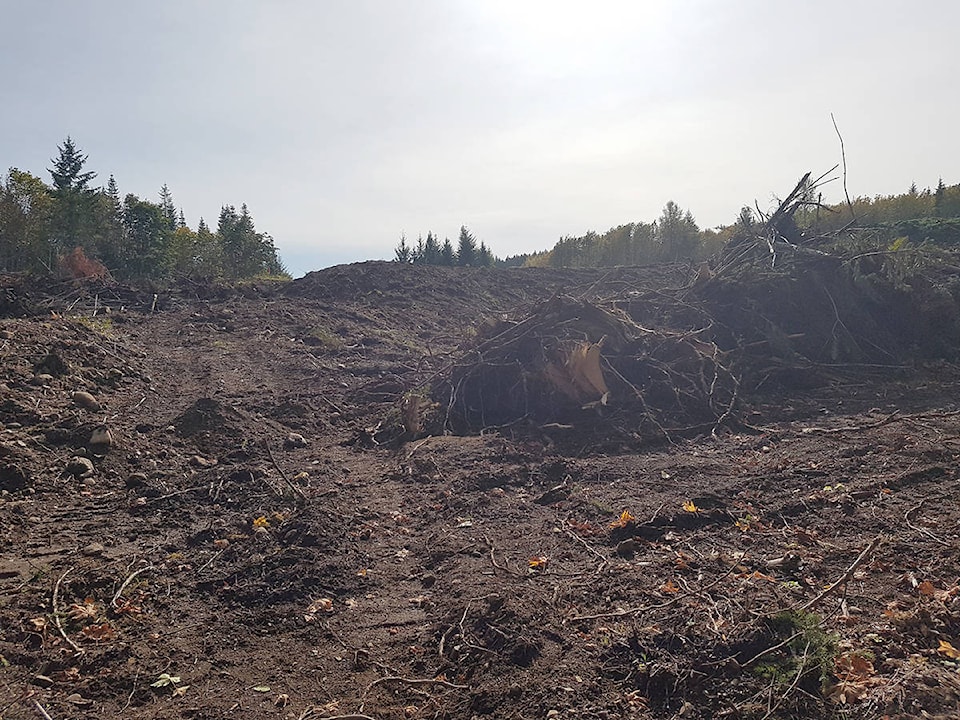While work on the Union Bay Estates (UBE) residential development has focused on the area to the east of Highway 19A, earlier this fall many trees were cleared from land near Washer Creek, also known as Hart Creek, that runs through the community.
If the spot is now clear of trees, the question as to jurisdiction and permit requirements remains less so.
The area that was cleared lies on a ridge above the creek bed, potentially providing material for borrow pits for development at UBE, formerly known as Kensington Island Properties, a massive development that includes residential areas of potentially up to 2,889 units. Borrow pits typically are used for material in construction and civil engineering. The Record contacted a representative of UBE about work at the site but has not heard back.
RELATED STORY: Directors recommend approval of Union Bay Discovery Centre
The Record also received a copy of a letter to the Ministry of Environment and Climate Change Strategy in September from resident Janet Thomas trying to find out about the logging – specifically about any stormwater management plans as well as environmental protection plans, particularly regarding fish and fish habitat protection for the Washer Creek floodplain.
“With the disappearance of old-growth trees on Vancouver Island and the fragmented mature forests, I believe that sensitive habitat areas such as the Washer Creek one west of 19A will play an increasingly important role in protecting fish and wildlife,” she says in the letter.
Thomas notes some apparent effects already such as increased air temperature due to the reduced tree canopy in the area.
“The whole Washer Creek Trail was previously shaded but with the recent tree felling, there is much more direct sun on the area which could impact the fish-bearing stream with higher temperatures,” she says.
A Ministry staff person sent a response saying they look after sewage treatment and discharge, and added the location seems to be part of a development permit area within the Comox Valley Regional District. The development permits focus on specific issues that need special consideration prior to development.
Thomas also sent a message to CVRD planners about whether there was a development permit for any borrow pit activities and was told there was no application. Another staff response on Oct. 6 said the environmental development permit area covers land within 30 metres of watercourses, including shorelines, and areas in the vicinity of known eagle or heron nests. In this case, the potential borrow pit area falls outside the 30-metre limit. It continues by noting the regional district also has a steep slopes development permit area, which is only applicable on slops of at least 30 degrees for at least three vertical metres, or areas within 7.5 metres of such a slope.
A CVRD spokesperson responded to the Record saying borrow pits are a provincial responsibility and that an aquatic or riparian development permit is not required in this case for UBE.
As far as the tree removal question, the CVRD also said it does not have a tree-cutting bylaw. However, the regional district has a page on its website with information about UBE, including environmental development permit areas. While the webpage does refer to the 30-metre limits for waterways, it also mentions that site alteration within permit areas – for example, removing trees – requires a permit.
In this case, the aquatic or riparian development permit does not apply though, according to the CVRD, but the question remains as to whether a steep slope permit would come into play and require a permit. The CVRD says it is working with UBE to determine if a development permit is required for steep slope work in the Washer Creek area.
mike.chouinard@comoxvalleyrecord.com
Like us on Facebook and follow us on Twitter.
